
Central Lawrenceville is a neighborhood in the northeast of Pittsburgh, Pennsylvania in the United States. It has a zip code of 15201, and has representation on Pittsburgh City Council by the council member for District 7. It is home to Allegheny Cemetery. Central Lawrenceville is the home of the Pittsburgh Bureau of Fire's 6 Engine and 6 Truck.

Lawrenceville is one of the largest neighborhood areas in Pittsburgh in the U.S. state of Pennsylvania. It is located northeast of downtown, and like many of the city's riverfront neighborhoods, it has an industrial past. The city officially divides Lawrenceville into three neighborhoods, Upper Lawrenceville, Central Lawrenceville, and Lower Lawrenceville, but these distinctions have little practical effect. Accordingly, Lawrenceville is almost universally treated as a single large neighborhood.
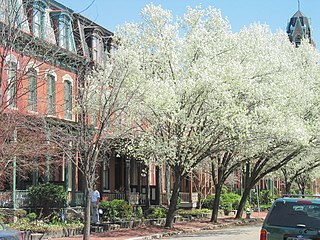
Manchester is a North Side neighborhood in Pittsburgh, Pennsylvania. The neighborhood is represented on Pittsburgh City Council by the District 6. Manchester houses PBF Battalion 1 & 37 Engine, and is covered by PBP Zone 1 and the Bureau of EMS Medic 4. The neighborhood includes the Manchester Historic District, which protects, to some degree, 609 buildings over a 51.6-acre (20.9 ha) area. The district was listed on the National Register of Historic Places in 1975. It uses ZIP code of 15233.

The Allegheny County Courthouse in downtown Pittsburgh, Pennsylvania, is part of a complex designed by H. H. Richardson. The buildings are considered among the finest examples of the Romanesque Revival style for which Richardson is well known.

The Mexican War Streets, originally known as the "Buena Vista Tract," is a historic district that is located in the Central Northside neighborhood of Pittsburgh, Pennsylvania, in the United States. The district is densely filled with restored row houses, community gardens, and tree-lined streets and alleyways. The area dates to around the time of the Mexican–American War.

The Pittsburgh City-County Building is the seat of government for the City of Pittsburgh, and houses both city and Allegheny County offices. It is located in Downtown Pittsburgh at 414 Grant Street. Built from 1915 to 1917 it is the third seat of government of Pittsburgh. Today the building is occupied mostly by Pittsburgh offices with Allegheny County located in adjacent county facilities. It also contains a courtroom used for the Pittsburgh sessions of the Supreme Court of Pennsylvania.

The Allegheny Arsenal, established in 1814, was an important supply and manufacturing center for the Union Army during the American Civil War, and the site of the single largest civilian disaster during the war. It was located in the community of Lawrenceville, Pennsylvania, which was annexed by the city of Pittsburgh in 1868.

The Arsenal School is a historic school building in the Lower Lawrenceville neighborhood of Pittsburgh, Pennsylvania. It houses both a middle school, Arsenal 6–8, and an elementary school, Arsenal PreK–5, operated by Pittsburgh Public Schools. The building originally opened in 1932 as a junior high school, with the elementary school addition completed in 1939. It stands on part of the former site of the Allegheny Arsenal.

The Woolslair Elementary School in the Bloomfield neighborhood of Pittsburgh, Pennsylvania is a building from 1898. It was listed on the National Register of Historic Places in 1986.
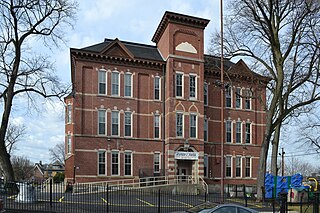
The Stephen C. Foster School, also known as the Stephen C. Foster Community Center, is a historic school building in the Central Lawrenceville neighborhood of Pittsburgh, Pennsylvania. It is named for composer Stephen Foster, whose father William Barclay Foster once owned the land on which the building is located. The school opened in 1886 and operated until 1939, when its students were transferred to the new elementary wing of Arsenal Junior High School. Since 1939, the building has been used as a community center.
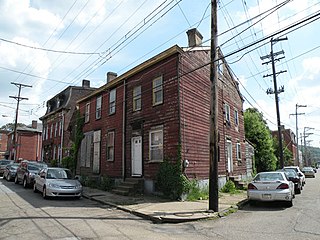
184 38th Street, also known as McBride Log House, was a historic log house in the Lawrenceville neighborhood of Pittsburgh, Pennsylvania. Before its demolition, it was thought to be the oldest log house in any major American city to be used as a residence.

Butler Street is a street in Pittsburgh, Pennsylvania which is the main commercial thoroughfare of the Lawrenceville neighborhood. Since the early 2000s, it has become a center for arts, dining, and music, with many local businesses including bars, restaurants, breweries, and specialty shops. It is named for the city of Butler, Pennsylvania, whose namesake was Maj. Gen. Richard Butler of the Continental Army.

The Carol Peterson House is located at 172 46th Street in the Lawrenceville neighborhood of Pittsburgh, Pennsylvania. The house was built in 1886–1887 in the Italianate architectural style, and is named after the architectural historian, Carol Peterson.

Naser's Tavern is a historic building in the Lawrenceville neighborhood of Pittsburgh, Pennsylvania, and a designated Pittsburgh historic landmark. It is thought to be the oldest surviving building on Butler Street, the main commercial street in Lawrenceville. The structure was probably built by John Kingan between 1833 and 1846, as the price of the property when Kingan sold it indicates there was already a substantial building on the site. At the time, it was at the edge of the built-up area of Butler Street, which spanned approximately one block on either side of the Allegheny Arsenal. John Naser, a German immigrant, bought the property in 1846 and operated an inn and tavern there which he called "Our House". His son Charles took over the business in the 1870s and expanded the building with several additions, including a second floor which was built sometime between 1893 and 1905. The Naser family sold the building in 1943. As of 2018 it houses a branch of Pennsylvania's state-run liquor store, Fine Wine & Good Spirits.
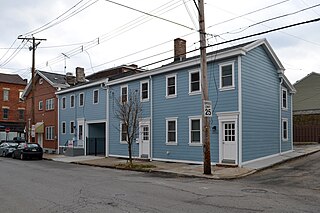
The Walton House is a historic building in the Lawrenceville neighborhood of Pittsburgh, Pennsylvania. A designated Pittsburgh historic landmark, the house and its neighboring structures exemplify the form and scale of buildings constructed in Lawrenceville during the post Civil War era.

The Lawrenceville Historic District is a U.S. historic district in Pittsburgh, Pennsylvania, which encompasses the majority of the Lawrenceville neighborhood. The historic district includes 3,217 contributing resources, many of which are rowhouses, commercial buildings, and former industrial properties built between the 1830s and early 20th century. The district was listed on the National Register of Historic Places in 2019.

The Pennsylvania National Bank Building is a historic building in the Lawrenceville neighborhood of Pittsburgh, Pennsylvania. It is located on a prominent site facing Doughboy Square, the acute intersection of Butler Street and Penn Avenue which is often considered the "entrance to Lawrenceville".
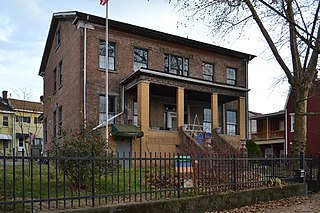
The Mowry-Addison Mansion is a historic house in the Upper Lawrenceville neighborhood of Pittsburgh, Pennsylvania, and a contributing property in the Lawrenceville Historic District. It was built in 1830–32 by Peter Mowry, a physician, and was originally part of a large estate that was subdivided into residential lots in 1872. The house is notable as a rare example of relatively well preserved Greek Revival architecture in Pittsburgh, and exemplifies the typical pattern of development in Lawrenceville in the mid to late 19th century. In 2020, the building was nominated as a Pittsburgh historic landmark by Preservation Pittsburgh, which stated that the mansion "is one of the last remaining and most significantly preserved regional ribbon farm dwellings from its period of construction."

The Ewalt House was a historic house in the Lawrenceville neighborhood of Pittsburgh, Pennsylvania, and a contributing property in the Lawrenceville Historic District. It was built as a country estate sometime between 1787 and 1840 by Samuel Ewalt, and remained standing after most of the land was subdivided for residential lots in the 1870s. The house was notable as a rare example of an antebellum style Greek Revival house in Pittsburgh, and exemplified the typical pattern of development in Lawrenceville in the mid to late 19th century. In 2019, the building was nominated as a Pittsburgh historic landmark.
Two buildings in Pittsburgh were known as the United States Marine Hospital. They were part of the U.S. Marine Hospital system, which was run by the Marine Hospital Service and its successor the Public Health Service, primarily for the benefit of the civilian merchant marine. The original hospital was located in Allegheny City and was used as a Marine Hospital during 1851–1875, after which it was sold. It was demolished in the late 1880s for construction of the Ohio Connecting Railroad Bridge.




















